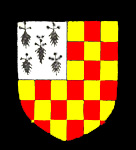The Manor of Oakley Reynes

The Roos family coat of arms
The histories of manors in Bedfordshire are given in Volume III of The Victoria County History for Bedfordshire published in 1912. Oakley Reynes Manor traces its history back to the manor in Oakley owned by Robert de Tosny in 1086, as recorded by Domesday Book. He had two men-at-arms as tenants. Overlordship passed from the de Tosny family to the Roos family of Hamlake and is last mentioned in 1512.

The Reynes family coat of arms
The earliest named tenant of the manor was Simon de Bosard in the 13th century. He had been succeeded by Richard de Bosard by 1278. Richard was succeeded by his sister Joan, who married Thomas Reynes and, possibly a man named Chamberlain after Reynes’ death. Joan and Thomas had a son Ralph Reynes who succeeded as Lord of the Manor after the death of his mother.
The Reynes family held the manor until at least 1451 when John Reynes died without male heirs. The manor then seems to have been divided between the Taylard and and Lestraunge families. Sir Laurence Taylard held half of the manor in 1548, inheriting it from Elizabeth Anstey, granddaughter of a sister of John Reynes who married William Taylard, Sir Laurence being their grandson. He was succeeded by his son who was succeeded by his daughter Catherine who married Robert Brudenell. This half of the manor remained in the hands of the Brudenell family until 1648 when Edmund Brudenell alienated it to Charles Mordaunt.

The Mordaunt family coat of arms
Robert Lestrange held the other half of the manor at his death in 1512. His son Thomas held it in 1533 but seems to have conveyed it to William Mordaunt. Both halves of the manor were reunited in Mordaunt ownership in 1648 as set out above. In 1679 Charles Mordaunt alienated the manor to Henry Lilly who was probably acting for Sir Creswell Levinz who became Lord of the Manor later in that year.
The manor remained the property of the Levinz family until 1757 when it was conveyed to John, 4th Duke of Bedford, the dukes holding the manor into the 20th century. A succession of Law of Property Acts in the 1920s extinguished all manorial incidents, courts and copyhold tenure of land. This effectively abolished manors in all but name.